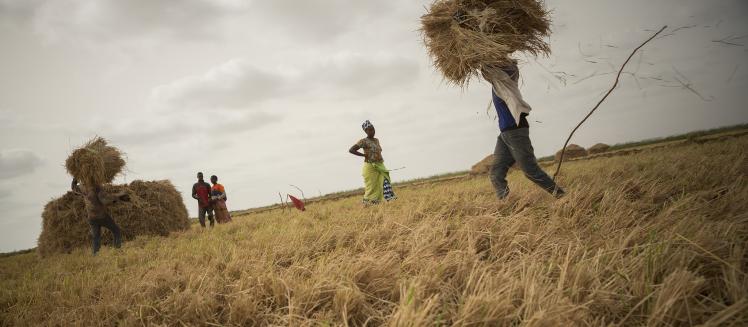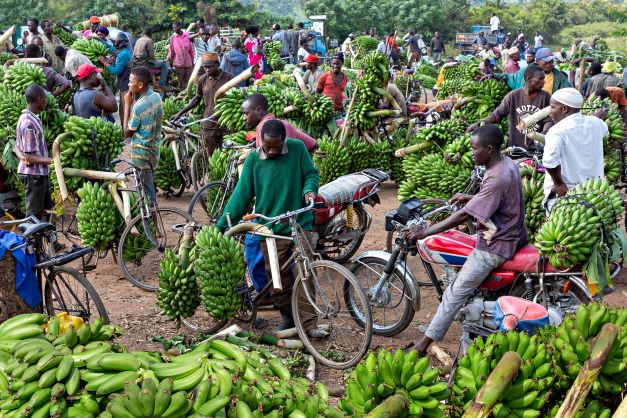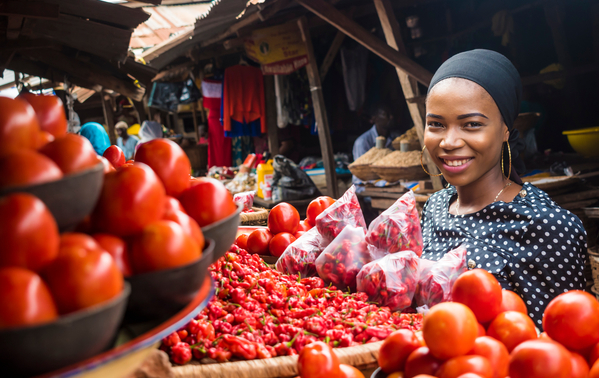
This post is written by Prapti Barooah, Fleur Wouterse, Smriti Saini, Muzna Alvi, and Claudia Ringler, IFPRI.
Globally, COVID-19 has exposed farmers to high levels of income insecurity, underlining the importance of building resilience among male and female farmers. Female farmers might be particularly vulnerable to COVID-19 impacts due to lower incomes, higher illiteracy, and limited access to resources, time poverty due to increasing domestic and productive responsibilities, and overall patriarchal norms including restrictions on mobility that prevent women from realizing their productive potential.
To better understand the differential impact of COVID-19 on male and female farmers, the International Food Policy Research Institute (IFPRI) is implementing a series of phone surveys with poor rural men and women in selected Feed-the-Future countries as part of the Gender, Climate Change, and Nutrition Integration Initiative (GCAN). Here we report preliminary findings from phone surveys with farmers in Nepal and Senegal.
The two countries represent similarities and differences in COVID-19 trajectories and implications. Both countries underwent strict lockdowns around the same time (March 23 for Senegal and March 24 for Nepal). Senegal lifted the lockdown on June 30 and Nepal continues with a lighter lockdown since June 15.
Inequities in coping with income loss
We conducted phone surveys in the Dang district of Province 5 in Nepal between late June to mid-July 2020 with a pool of 462 women and 194 men farmers. The surveys found that more than 85 percent of male and female respondents reported a loss in household income due to the pandemic. In Senegal, where 424 male household heads and 79 female household heads were surveyed across the country, more than 90 percent of households reported income losses.
In Nepal, the main coping mechanisms for income losses have been the reliance on savings (70 percent of respondents) and borrowing funds (51 percent). A slightly larger share of women sold assets (10 percent versus 9 percent for men) and households also relied on government transfers (13-14 percent of respondents). Savings used tended to be those of the male decision-maker, and most women (82 percent) reported lower incomes than their spouses. These findings emphasize women’s dependence on their spouses in times of financial crises. Key sources for borrowing funds to cope with COVID-19 are neighbors and friends, followed by a rotating savings scheme, which can be linked to the Dhukuti system and is widely prevalent in Nepal. Women are slightly more likely to rely on family members for borrowing.
In Senegal, male respondents resorted to savings or sold off assets, whereas women heads of households were more likely to borrow to deal with the loss of income.
Inequities in mobility
For Nepal, 45 percent of households reported outward migration in the last year, mostly to urban areas in Nepal or other South Asian countries. Most migrants were men (92%) leaving women as the de-facto agricultural decision-makers behind. As a result of the COVID-19 lockdown, about 40 percent of men and 20 percent of women who had migrated, returned. More than 90 percent of male and female respondents shared that their mobility has reduced due to COVID-19.
While migration is not as prevalent in rural Senegal, a quarter of households reported outward migration to Dakar or Europe. Contrary to Nepal, male-dominated outmigration did not substantially affect changes in women’s roles in agriculture. This was because of extended family systems where other male members took on the agricultural roles and responsibilities of the migrant spouse. The quarter of the survey sample in Senegal noted that a migrant had returned. Following initial return migration, mobility declined. A little over three-quarters of male respondents indicated to be less mobile than before COVID-19, whereas most female respondents reported a decline in mobility.
Inequities in time burden
The disparity in workload between men and women has been a critical factor constraining women’s productive potential. In Nepal, despite the lockdown in the week preceding the survey, 88 percent of female respondents were involved in productive work and one-third of women reported an increase in productive work. At the same time, women continued to care for other household members. The increase in the time poverty of women due to their increased workload enhances their vulnerabilities.
In Senegal, 63 percent of female heads of household had worked in the past seven days compared with 83 percent of male heads. At the same time, 40 percent of women respondents noted an increase in time spent caring for other household members; 30 percent of men reported a similar increase.
Water and food insecurity
In Nepal, women reported more often having insufficient food, eating less, skipping meals and going hungrier than their male counterparts (Figure 1). This will likely impact their nutritional status and make them more vulnerable to diseases. In Senegal, over 80 percent of respondents indicated that their access to food had declined since the pandemic. To cope with reduced access to food, around 70 percent of male-headed households and 55 percent of female-headed households had shifted to a cheaper, but less nutritious, diet (Figure 1). During the two weeks preceding the survey, food insecurity was very high for both male and female respondents in Senegal, with 77 percent of male and 63 percent of women-headed households worrying about not having enough to eat. While the share of female-headed households skipping meals and going hungry was slightly higher than that for male-headed households; male-headed households were more likely to resort to eating less and less nutritious food.
|
Women and girls are also often the first ones to get affected by water scarcity given that they are primarily responsible for managing the household water supply. We find a higher proportion of women worrying about water availability than men in both countries. The water situation in June/July was a lot direr in Senegal with 43 percent of households reporting challenges around household water security (Figure 2). Moreover, challenges were larger for female-headed households, where 17 percent always or often worried about accessing water. Other salient WASH (Water Supply, Sanitation and Hygiene) figures for Senegal are similarly worrying: almost every fifth household needed more than 30 minutes to fetch water; and 30 percent of male-headed and 45 percent of female-headed households had no access to a toilet or latrine. These indicators expose these households not only to COVID-19 but also to other diseases.
|
Figure 2: Abbreviated Household Water Insecurity Experiences Scale: Worrying about Water Availability |
The results from Nepal and Senegal show that women and men are differentially impacted in the two countries. While the COVID-19 lockdown has been lifted in Senegal, water and food shortages are felt more deeply in rural Senegal than in Nepal. However, Nepal has to cope with a much larger influx of returning migrants in rural areas.
The findings also highlight the differential impact of the pandemic on men and women farmers, female-headed households, and draws attention to the need of rapid support to address short-term impacts related to food and water insecurity, but also longer-term needs to address the growing debt that women and female-headed households accumulate, as well as interventions that reduce their time burden. If short-term and longer-term needs are not addressed, women’s agency could dramatically decline going forward.
This blog was originally posted on agrilinks.org



